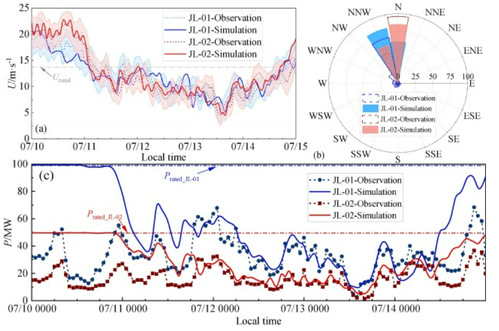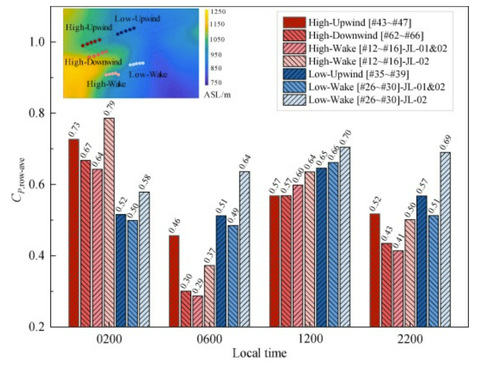Enhancing the power production efficiency of large-scale wind farms is challenging for onshore wind power due to the variability of atmospheric conditions. Recently, Professor Kun Luo, Professor Jianren Fan and collaborators from Department of Energy Engineering, Zhejiang University, and Shanghai Institute for Advanced Study of Zhejiang University published article ‘Diurnal impact of atmospheric stability on inter-farm wake and power generation efficiency at neighboring onshore wind farms in complex terrain’ in Energy Conversion and Management, using a refined wind farm parameterization to reflect inter-farm interaction. Based on simulation of two wind farms in China, they found that the inter-farm wake and power production changes shown the diurnal cycles, and the downwind farm power loss at night was 3 times larger than that at daytime. They also discovered that the largest power production losses were suffered before dawn and after dusk, and topographic effect in the stable layer outperforms in unstable conditions.
The work was designed to study the impact of atmospheric stability on the inter-farm wake pattern, topographic effect, and power production changes at two neighboring wind farms in Hami City, Xinjiang of China over complex terrain.


The results shown a discernible diurnal cycle property. At night in a stable layer with hindered mixing, the inter-farm wake persists around 20 km downstream, and the greatest relative wind deficit increases by 8%. However, during the daytime unstable layer with elevated turbulence, shown a limited deficit and recovers about 6 km downstream. Accordingly, a mean relative power production reduction of 17% was subjected to the downwind farm at night, about a factor of 3 greater than that at daytime, when the mean value was only 6%. Interestingly, the largest power production losses were experienced with a larger range between maximum and minimum before dawn and after dusk due to the notable inter-farm wake with a streaky structure related to the large coherent buoyant caused by the tendency of heat flux over the complex terrain. Moreover, the topographic speed-up in the stable layer outperformed that in unstable conditions.

These results demonstrated that factors like atmospheric stability, topography, and wind throughout the diurnal cycles were important to qualify the wake patterns and power production changes generated by the upwind farms. Such influence should be considered to implement the processes of accurate simulations and guidance for the planning or construction of wind power bases. Future works are needed to investigate the seasonal impacts of atmospheric stability on inter-farm wake and performance, as well as to explore such influence on inter-farm wake and performance for offshore wind farms under the marine atmospheric boundary layer.
To access the work, please check https://www.sciencedirect.com/science/article/pii/S0196890422006938#f0005.
About Professor Luo
Kun Luo is a professor at Zhejiang University. He is a Distinguished Young Scholar, and is a member of the Chinese Society of Engineering Thermophysics, Deputy Secretary General of the Multiphase Flow Committee of the Chinese Society of Engineering Thermophysics, and Deputy Secretary General of the Process Simulation and Simulation Committee of the Chinese Chemical Society.
He received his bachelor's degree from Wuhan University of Water Resources and Electric Power in July 2000 and was promoted to professor in December 2010 after receiving his Ph.D. in engineering thermophysics from Zhejiang University in March 2005. University (2003).
For many years, he has been engaged in theoretical modeling and numerical simulation of complex multi-scale coupled problems in power and environmental engineering, including computational multiphase flow, computational combustion, multi-scale simulation of wind energy utilization, and multi-scale modeling of air quality in atmospheric pollution areas. He proposed a new method for direct numerical simulation of complex large-scale multiphase turbulent combustion processes, discovered new phenomena and mechanisms of coupling multiphase turbulent combustion processes at the interface, developed a new model for more accurate engineering calculations, and successfully applied it to engineering practice, which brought obvious economic and environmental benefits. As a project leader and research manager, he has conducted more than ten national/provincial research projects and published more than 200 papers in scholarly journals.
About Professor Jianren Fan
Professor Jianren Fan received his PhD from the Department of Mechanics, Vienna University of Technology (Technischen Universität Wien) in Austria in 1984. In the same year, he returned to Zhejiang University in China and later became a Changjiang Chair Professor. In 1994, he was awarded the first National Distinguished Young Scholar from National Natural Science Foundation of China and also received the Outstanding Contribution to Overseas Students Award from the State Education Commission and the Ministry of Human Resources of China. Currently he is a Professor of College of Energy Engineering, Zhejiang University, and an Adjunct Professor of Shanghai Institute for Advanced Study of Zhejiang University (SIAS).
He is mainly engaged in the research of multiphase flow theory and computational combustion fluid dynamics. In recent years, professor Fan has led more than 10 national research projects and was awarded national and provincial awards. He has co-authored 3 monographs and published more than 100 journal articles.
About SIAS
Shanghai Institute for Advanced Study of Zhejiang University (SIAS) is a jointly launched new institution of research and development by Shanghai Municipal Government and Zhejiang University in June, 2020. The platform represents an intersection of technology and economic development, serving as a market leading trail blazer to cultivate a novel community for innovation amongst enterprises.
SIAS is seeking top talents working on the frontiers of computational sciences who can envision and actualize a research program that will bring out new solutions to areas include, but not limited to, Artificial Intelligence, Computational Biology, Computational Engineering and Fintech.

